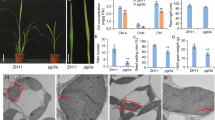Abstract
The ubiquitin-26S proteasome system is important in the quality control of intracellular proteins. The ubiquitin-26S proteasome system includes the E1 (ubiquitin activating), E2 (ubiquitin conjugating), and E3 (ubiquitin ligase) enzymes. U-box proteins are a derived version of RING-finger domains, which have E3 enzyme activity. Here, we present the isolation of a novel U-box protein, U-box containing E3 ligase induced by phosphate starvation (OsUPS), from rice (Oryza sativa). The cDNA encoding the O. sativa U-box protein (OsUPS) comprises 1338 bp, with an open reading frame of 445 amino acids. The amino acid sequence of OsUPS cDNA shows 41–79% identity with other plant U-box homologous genes. The open reading frame of the OsUPS protein is comprised of notable domains: a single ~70-amino acid domain and a GKL domain that contains conserved glycine, lysine/arginine residues and leucine-rich feature. We found that full-length expression of OsUPS was up-regulated in both rice plants and cell culture in the absence of inorganic phosphate (Pi). A self-ubiquitination assay indicated that the bacterially expressed OsUPS protein had E3 ligase activity, and subcellular localization results showed that OsUPS was located in the chloroplast. These results support the notion that OsUPS plays an important role in the Pi signaling pathway through the ubiquitin-26S proteasome system.



Similar content being viewed by others
References
Raghothama KG (2000) Phosphate transport and signaling. Curr Opin Plant Biol 3:182–187
Raghothama KG (1999) Phosphate acquisition. Annu Rev Plant Physiol Plant Mol Biol 50:665–693
Williamson LC, Ribrioux SPCR, Fitter AH, Leyser HMO (2001) Phosphate availability regulates root system architecture in Arabidopsis. Plant Physiol 126:875–882
Zhou J, Jiao F, Wu Z, Wang X, He X, Zhong W, Wu P (2008) OsPHR2 is involved in phosphate-starvation signaling and excessive phosphate accumulation in shoots of plants. Plant Physiol 146:1673–1686
Wang C, Ying S, Huang H, Li K, Wu P, Shou H (2009) Involvement of OsSPX1 in phosphate homeostasis in rice. Plant J 57:895–904
Zeng LR, Qu S, Bordeos A, Yang C, Baraoidan M, Yan H, Xie Q, Nahm BH, Leung H, Wang GL (2004) Spotted leaf11, a negative regulator of plant cell death and defense, encodes a U-box/armadillo repeat protein endowed with E3 ubiquitin ligase activity. Plant Cell 16(10):2795–2808
Itoh H, Matsuoka M, Steber CM (2003) A role for the ubiquitin-26S-proteasome pathway in gibberellin signaling. Trends Plant Sci 8(10):492–497
Park JJ, Yi J, Yoon J, Cho LH, Ping J, Jeong HJ, Cho SK, Kim WT, An G (2011) OsPUB15, an E3 ubiquitin ligase, functions to reduce cellular oxidative stress during seedling establishment. Plant J 65:194–205
Glickman MH, Ciechanover A (2002) The ubiquitin-proteasome proteolytic pathway: destruction for the sake of construction. Physiol Rev 2:373–428
Vierstra RD, Callis J (1999) Polypeptide tags, ubiquitous modifiers for plant protein regulation. Plant Mol Biol 41(4):435–442
Ciechanover A, Orian A, Schwartz AL (2000) Ubiquitin-mediated proteolysis: biological regulation via destruction. Bioessays 22(5):442–451
Smalle J, Vierstra RD (2004) The ubiquitin 26S proteasome proteolytic pathway. Annu Rev Plant Biol 55:555–590
Scheffner M, Huibregtse JM, Vierstra RD, Howley PM (1993) The HPV-16 E6 and E6-AP complex functions as a ubiquitin-protein ligase in the ubiquitination of p53. Cell 3:495–505
Borden KL (2000) RING domains: master builders of molecular scaffolds? J Mol Biol 295(5):1103–1112
Koegl M, Hoppe T, Schlenker S, Ulrich HD, Mayer TU, Jentsch S (1999) A novel ubiquitination factor, E4, is involved in multi-ubiquitin chain assembly. Cell 96:635–644
Aravind L, Koonin EV (2000) The alpha/beta fold uracil DNA glycosylases: a common origin with diverse fates. Genome Biol 1(4)
Yu SM, Kuo YH, Sheu G, Sheu YJ, Liu LF (1991) Metabolic derepression of alpha-amylase gene expression in suspension-cultured cells of rice. J Biol Chem 266:21131–21137
Zhang Q, Saghai Maroof MA, Lu TY, Shen BZ (1992) Genetic diversity and differentiation of indica and japonica rice detected by RFLP analysis. Theor Appl Genet 83:495–499
Cho SK, Chung HS, Ryu MY, Park MJ, Lee MM, Bahk YY, Kim J, Pai HS, Kim WT (2006) Heterologous expression and molecular and cellular characterization of CaPUB1 encoding a hot pepper U-Box E3 ubiquitin ligase homolog. Plant Physiol 142(4):1664–1682
Abel S, Theologis A (1994) Transient transformation of Arabidopsis leaf protoplasts: a versatile experimental system to study gene expression. Plant J 5:421–427
Thompson JD, Gibson TJ, Plewniak F, Jeanmougin F, Higgins DG (1997) The ClustalX windows interface: flexible strategies for multiple sequence alignment aided by quality analysis tools. Nucleic Acids Res 24:4876–4882
Zeng LR, Park CH, Venu RC, Gough J, Wang GL (2008) Classification, expression pattern, and E3 ligase activity assay of rice U-box-containing proteins. Mol Plant 5:800–815
Yang CW, González-Lamothe R, Ewan RA, Rowland O, Yoshioka H, Shenton M, Ye H, O’Donnell E, Jones JD, Sadanandom A (2006) The E3 ubiquitin ligase activity of arabidopsis plant U-BOX17 and its functional tobacco homolog ACRE276 are required for cell death and defense. Plant Cell 18(4):1084–1098
Acknowledgments
This work was supported by a grant from the Next-Generation BioGreen 21 Program (Plant Molecular Breeding Center No. PJ008035 and GM Crops Center No. PJ008101), Rural Development Administration, Republic of Korea.
Author information
Authors and Affiliations
Corresponding author
Electronic supplementary material
Below is the link to the electronic supplementary material.
Rights and permissions
About this article
Cite this article
Hur, YJ., Yi, Y.B., Lee, J.H. et al. Molecular cloning and characterization of OsUPS, a U-box containing E3 ligase gene that respond to phosphate starvation in rice (Oryza sativa). Mol Biol Rep 39, 5883–5888 (2012). https://doi.org/10.1007/s11033-011-1399-5
Received:
Accepted:
Published:
Issue Date:
DOI: https://doi.org/10.1007/s11033-011-1399-5




